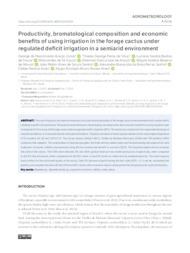Productivity, bromatological composition and economic benefits of using irrigation in the forage cactus under regulated deficit irrigation in a semiarid environment.
Productivity, bromatological composition and economic benefits of using irrigation in the forage cactus under regulated deficit irrigation in a semiarid environment.
Author(s): ARAÚJO JÚNIOR, G. do N.; SILVA, T. G. F. da; SOUZA, L. S. B. de; SOUZA, M. de S.; ARAUJO, G. G. L. de; MOURA, M. S. B. de; SANTOS, J. P. A. de S.; JARDIM, A. M. da R. F.; ALVES, C. P.; ALVES, H. K. M. N.
Summary: The use of irrigation can improve the productivity and nutritional quality of the forage cactus in environments with a water deficit, resulting in profit to the producer. The productive performance, bromatological composition and economic benefits of using irrigation were investigated in this study with forage cactus clones regulated deficit irrigation (RDI). The study was conducted in an experimental design of randomised blocks, in a factorial scheme with subdivided plots. The plots consisted of water regimes based on the crop evapotranspiration (ETc) (rainfed, 40, 80 and 120% ETc). The cactus clones [?Miúda? (MIU), ?Orelha de Elefante Mexicana? (OEM) and ?IPA Sertânia? (IPA)] comprised the subplots. The total number of cladodes per plant, the fresh and dry matter yields and the bromatological composition were evaluated. Economic viability was assessed using the net revenue and benefit to cost ratio (BCR). The irrigation depths did not increase the yield of the clones. The OEM clone showed 276 and 343% greater fresh and dry matter production, respectively, when compared to the IPA clone; however, when compared with the MIU clone, it was 63%, both on a fresh and dry matter production. The water regimes had no effect on the nutritional quality of the cactus. Only IPA showed no profit during the first cycle (BCR < 1). It can be concluded that planting one irrigated hectare with the OEM and MIU clones offer economic returns starting from the first production cycle (18 months).
Publication year: 2021
Types of publication: Journal article
Unit: Embrapa Semi-arid Region
Observation
Some of Embrapa's publications are published as ePub files. To read them, use or download one of the following free software options to your computer or mobile device. Android: Google Play Books; IOS: iBooks; Windows and Linux: Calibre.
Access other publications
Access the Agricultural Research Database (BDPA) to consult Embrapa's full library collection and records.
Visit Embrapa Bookstore to purchase books and other publications sold by Embrapa.

